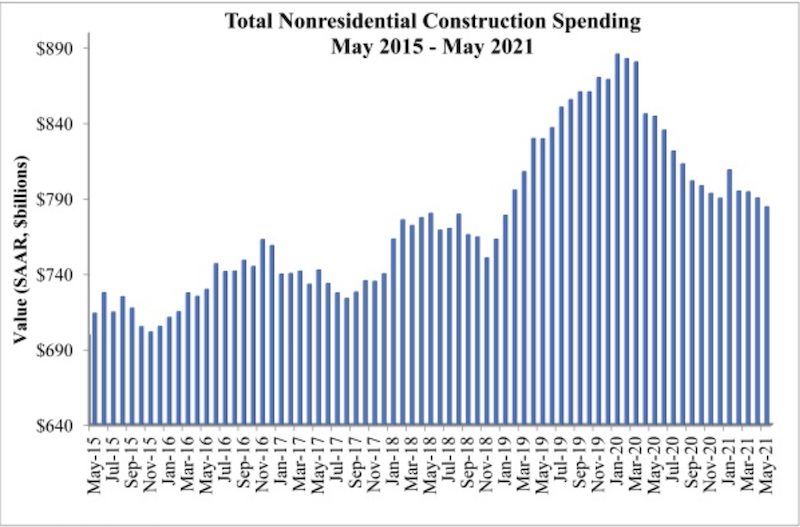In its first-quarter index of Construction Confidence, the Associated Builders and Contractors (ABC) found that 55% of contractors expected their sales to increase over the following six months, and only 19% thought their sales would decline in that period.
They might need to recalibrate their exuberance, in light of the trade group’s latest analysis of data published by the U.S. Census Bureau, which ABC released today. It estimates that national nonresidential construction spending in May, at $784.5 billion, was down 7.1% from the same month a year ago, and off 0.7% from spending levels in April 2021.
On a year-over-year basis, spending for every nonresidential category that ABC tracks, except sewage and waste disposal, was negative. Spending on public safety projects—which surged during the early months of the pandemic—showed the greatest decline in May, 39.6%, and lodging also took a big hit (off 23.3% to $22.6 billion). On the other hand, spending in May on healthcare construction, nearly $47 billion, was down only marginally, by 1.5%, compared to the same month a year ago.
WORKER SHORTAGES AND MATERIAL PRICING REMAIN PROJECT ROADBLOCKS

Construction spending for public safety and lodging projects showed the steepest declines in May compared to the same month a year ago.
A red-hot data center market hasn’t spelled more office construction, notes Anirban Basu, ABC’s Chief Economist. Basu also points out that while some private construction segments are struggling under the dislocating impacts of the pandemic, public nonresidential construction actually has declined more rapidly than the private sector over the past year.
Basu sees some hope for the future. Public construction spending should benefit from improvements in state and local governments’ financial conditions. But he tempers his predictions because of still-high construction materials prices and “deeply problematic” worker shortages. Basu expressed some concern, too, about the disproportionate amount of spending moving toward residential construction, which accounted for 41% of the pre-pandemic total and 49% in May.
Related Stories
Multifamily Housing | Jul 11, 2023
Converting downtown office into multifamily residential: Let’s stop and think about this
Is the office-to-residential conversion really what’s best for our downtowns from a cultural, urban, economic perspective? Or is this silver bullet really a poison pill?
Contractors | Jul 11, 2023
The average U.S. contractor has 8.9 months worth of construction work in the pipeline, as of June 2023
Associated Builders and Contractors reported that its Construction Backlog Indicator remained unchanged at 8.9 months in June 2023, according to an ABC member survey conducted June 20 to July 5. The reading is unchanged from June 2022.
Codes | Jul 10, 2023
Water Demand Calculator outperforms traditional plumbing codes for energy, carbon, and water savings
Using IAPMO’s Water Demand Calculator tool can result in energy, carbon, and water savings as compared to using traditional plumbing specification methods in plumbing codes, according to a study by Arup.
Adaptive Reuse | Jul 10, 2023
California updates building code for adaptive reuse of office, retail structures for housing
The California Building Standards Commission recently voted to make it easier to convert commercial properties to residential use. The commission adopted provisions of the International Existing Building Code (IEBC) that allow developers more flexibility for adaptive reuse of retail and office structures.
Laboratories | Jul 10, 2023
U.S. Department of Agriculture opens nation’s first biosafety level 4 containment facility for animal disease research
Replacing a seven-decade-old animal disease center, the National Bio and Agro-Defense Facility includes the nation’s first facility with biosafety containment capable of housing large livestock.
Market Data | Jul 5, 2023
Nonresidential construction spending decreased in May, its first drop in nearly a year
National nonresidential construction spending decreased 0.2% in May, according to an Associated Builders and Contractors analysis of data published today by the U.S. Census Bureau. On a seasonally adjusted annualized basis, nonresidential spending totaled $1.06 trillion.
Contractors | Jun 30, 2023
Construction industry task force aims for standardized carbon reporting
A newly formed Associated General Contractors of America (AGC) task force on decarbonization and carbon reporting will address the challenges around reporting and reducing carbon emissions in the construction industry.
Standards | Jun 30, 2023
New ASHRAE standard aims to reduce disease transmission risk in indoor spaces
ASHRAE Standard 241, Control of Infectious Aerosols establishes minimum requirements to reduce the risk of disease transmission by exposure to infectious aerosols in new buildings, existing buildings, and major renovations. Infectious aerosols are tiny, exhaled particles that can carry pathogens that cause infections or disease.
Mixed-Use | Jun 29, 2023
Massive work-live-play development opens in LA's new Cumulus District
VOX at Cumulus, a 14-acre work-live-play development in Los Angeles, offers 910 housing units and 100,000 sf of retail space anchored by a Whole Foods outlet. VOX, one of the largest mixed-use communities to open in the Los Angeles area, features apartments and townhomes with more than one dozen floorplans.
School Construction | Jun 29, 2023
K-12 school construction: 5 ways strong community relations can lead to success
When constructing a K-12 school, building positive relationships with the community—including students, parents, school staff and residents—is critical to the success of the project. Here are five ways Skanska puts the community first when building K-12 schools in the Pacific Northwest.

















